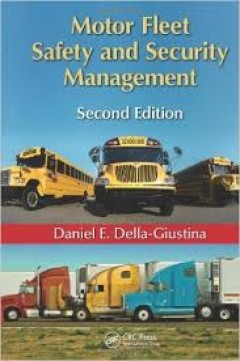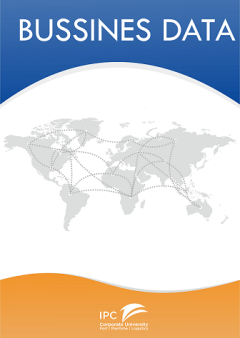Ditapis dengan

Transportasi Laut Kapal Layar Motor Pinisi
- Edisi
- -
- ISBN/ISSN
- 979-530-043-1
- Deskripsi Fisik
- -
- Judul Seri
- -
- No. Panggil
- SC TXT TRA m
- Edisi
- -
- ISBN/ISSN
- 979-530-043-1
- Deskripsi Fisik
- -
- Judul Seri
- -
- No. Panggil
- SC TXT TRA m

Motor Fleet Safety And Security Management
To achieve optimum safety, everyone involved in the transportation system should be adequately trained, supervised, and monitored. Proper data and incident reports must be maintained to identify trends and problem areas. Keeping the trademark style that made the previous edition so popular, the author addresses the critical steps for successful driver selection, training, instruction, and super…
- Edisi
- Second Ed.
- ISBN/ISSN
- 978-1-4398-9507-8
- Deskripsi Fisik
- xxi, 163 p., 23 cm
- Judul Seri
- -
- No. Panggil
- TXT LO DEL m

Automated shunting of rail container wagons in ports and terminal areas
The development of intermodal container transport is hampered in part by the cost associated with the shunting of trains in marshalling yards, inland and port railway terminals. Many new technologies have been developed in the past decade, but have still not been applied because of high capital investment costs, lack of sufficient market demand and uncertain rates of return. The key for increas…
- Edisi
- Vol. 27, No. 5, pp. 385–401
- ISBN/ISSN
- 1029-0354
- Deskripsi Fisik
- 19 p.
- Judul Seri
- Transportation Planning and Technology
- No. Panggil
- ATC LO HAN a

Modelling the consequences of a strategic supply chain initiative of an autom…
Describes the use of a decision support system (DSS) in part of a strategic supply chain initiative of an international automotive aftermarket organisation undertaken in 1996-97. The strategic initiative consisted of four distinct stages; a review of the current state, definition of the future vision, development of the operational blueprint and its implementation. A simulation based decision s…
- Edisi
- Vol. 29 No. 9, 1999
- ISBN/ISSN
- -
- Deskripsi Fisik
- 18 p.
- Judul Seri
- International Journal of Physical Distribution & Logistics Management
- No. Panggil
- ATC LO NAI m

Speeding up the progress curve towards effective supply chain management
Introduces a supply chain “health check” procedure successfully applied in the European automotive sector and presents the results for the analysis of 20 trans‐European value streams covering a wide range of first and second tier suppliers. The health check procedure is activated via a quick scan methodology (QSM) requiring execution by a multi‐disciplinary team working on‐site. The d…
- Edisi
- Vol. 5 Issue: 3, pp.122-130
- ISBN/ISSN
- -
- Deskripsi Fisik
- 12 p.
- Judul Seri
- Supply Chain Management: An International Journal
- No. Panggil
- ATC LO DIS s

Waves, beaches, breakwaters and rip currents – A three-dimensional view of …
Describes a two‐ and, later, a three‐dimensional view of supply chain dynamics within a theoretical framework derived from research carried out in the UK automotive industry. However, the authors believe that the models developed have a far wider applicability than this narrow sectoral and geographic focus. The research has been developed within two research programmes. The first programme,…
- Edisi
- Vol. 30 Issue: 10, pp.827-846
- ISBN/ISSN
- -
- Deskripsi Fisik
- 22 p.
- Judul Seri
- International Journal of Physical Distribution & Logistics Management
- No. Panggil
- ATC LO HIN w

Integrating the automotive supply chain: where are we now?
Real world supply chains differ not only in their current standard of performance, but also in the most effective actions required to move each towards world class supply. A generic approach for the identification of the appropriate re‐engineering programmes based on the uncertainty circle principle is presented. A total of 20 European automotive supply chains have been analysed via a “quic…
- Edisi
- Vol. 32 Issue: 2, pp.79-95
- ISBN/ISSN
- -
- Deskripsi Fisik
- 20 p.
- Judul Seri
- International Journal of Physical Distribution & Logistics Management
- No. Panggil
- ATC LO DIS i

Motorway of the sea port requirements: the viewpoint of port authorities
The short sea shipping reports presented by the European Commission have shown that this industry segment is still lagging behind road transport and suffering from numerous constraints. To foster the elimination of the latter, the 2003 action programme on the promotion of short sea shipping presented 14 measures, one of which concerned motorways of the sea. In this respect, the 2003 High Level …
- Edisi
- Volume 11
- ISBN/ISSN
- ISSN: 1367-5567
- Deskripsi Fisik
- 17 pages
- Judul Seri
- A Leading Journal of Supply Chain Management
- No. Panggil
- ATC PO CAS m

Indonesia Autos report : Includes 5-year forecasts to 2021
Sluggish private consumption and flat economic growth has led us revise down our vehicle sales forecast for Indonesia to growth of 4.9% in 2017, down from our previous forecast of a 9.5% expansion.
- Edisi
- Q4 2017
- ISBN/ISSN
- 1748-9954
- Deskripsi Fisik
- 59 p.
- Judul Seri
- Part of BMI’s Industry Report & Forecasts Series
- No. Panggil
- BD BMI i

Indonesia Autos report Includes 5-year forecasts to 2021
Vehicle sales in Indonesia will grow 9.5% in 2017, totalling 1.2mn units, supported by a strengthening economy, low borrowing costs and muted inflationary pressures.
- Edisi
- Q3 2017
- ISBN/ISSN
- 1748-9954
- Deskripsi Fisik
- 52 p.
- Judul Seri
- -
- No. Panggil
- BD BMI i

The Volvo Uddevalla plant and interpretations of industrial design processes
Argues that the design of the Volvo Uddevalla plant may be described as a process with an “internal logic” in which design options were eliminated through irreversible design decisions until only one alternative remained ‐ an unorthodox alternative comprising, for example, long cycle time work never used before for full‐scale production of automobiles. Contends that the most innovativ…
- Edisi
- Vol. 9 Issue: 5, pp.279-295
- ISBN/ISSN
- -
- Deskripsi Fisik
- 19 p.
- Judul Seri
- Integrated Manufacturing Systems
- No. Panggil
- ATC LO ENG t

Jobless learn warehousing skills at Euro Car Parts academy: Financially attra…
The purpose of this paper is to observe how the Euro Car Parts (ECP) academy is helping the expanding business to recruit trained and willing employees.
- Edisi
- Vol. 22 Issue: 3, pp.11-13
- ISBN/ISSN
- -
- Deskripsi Fisik
- 4 p .
- Judul Seri
- Human Resource Management International Digest
- No. Panggil
- ATC LO NON j

Is there any magic in cross-docking?
Exel Logistics’ experience in a number of industry sectors, product profiles, operational techniques and technology suggests that the outputs of cross‐docking can appear magical, even though they result from fairly standard operational inputs. Explains the origins of cross‐docking and explores the operational aspects of switching from a traditional stockholding supply chain system to a cr…
- Edisi
- Vol. 2 Issue: 2, pp.49-52
- ISBN/ISSN
- -
- Deskripsi Fisik
- 6 p .
- Judul Seri
- Supply Chain Management: An International Journal
- No. Panggil
- ATC LO KIN i

Investigating the sources and causes of schedule instability
The sources and consequences of schedule instability at an automotive assembler producing two models on the same assembly track are described. One model was produced under conditions of relatively lengthy stable schedules, the other under more unstable schedule conditions. The two logistics processes were compared, and measures of schedule uncertainty identified. The relative impact on human …
- Edisi
- Vol. 8 Issue: 2, pp.75-82
- ISBN/ISSN
- -
- Deskripsi Fisik
- 10 p.
- Judul Seri
- The International Journal of Logistics Management
- No. Panggil
- ATC LO HAR i

Impact of real-time information for scheduling a car-body shop – a simulati…
In a system where two material flows with sequence dependency are matched, the use of real‐time information to monitor and control the sequencing buffer improves the system′s ability to schedule many different models, compared with a system with no information at all. In the latter case, the system is upset considerably when more than four different models enter the system. Shows how the …
- Edisi
- Vol. 14 Issue: 3, pp.114-125
- ISBN/ISSN
- -
- Deskripsi Fisik
- 14 p.
- Judul Seri
- International Journal of Operations & Production Management
- No. Panggil
- ATC LO LUM i

Automated JIT based materials management for lot manufacture
The challenge facing manufacturing today is one of providing the customer with greater product variety deliverable in ever shorter lead‐times, while minimizing development and operating costs. Presents an integrated logistics and manufacturing process implemented in an automotive environment designed to address some of the key issues arising from this challenge. Uses a combination of stabiliz…
- Edisi
- Vol. 16 No. 3, 1996, pp. 62-75.
- ISBN/ISSN
- -
- Deskripsi Fisik
- 16 p .
- Judul Seri
- International Journal of Operations & Production Management
- No. Panggil
- ATC LO JIN a
 Karya Umum
Karya Umum  Filsafat
Filsafat  Agama
Agama  Ilmu-ilmu Sosial
Ilmu-ilmu Sosial  Bahasa
Bahasa  Ilmu-ilmu Murni
Ilmu-ilmu Murni  Ilmu-ilmu Terapan
Ilmu-ilmu Terapan  Kesenian, Hiburan, dan Olahraga
Kesenian, Hiburan, dan Olahraga  Kesusastraan
Kesusastraan  Geografi dan Sejarah
Geografi dan Sejarah